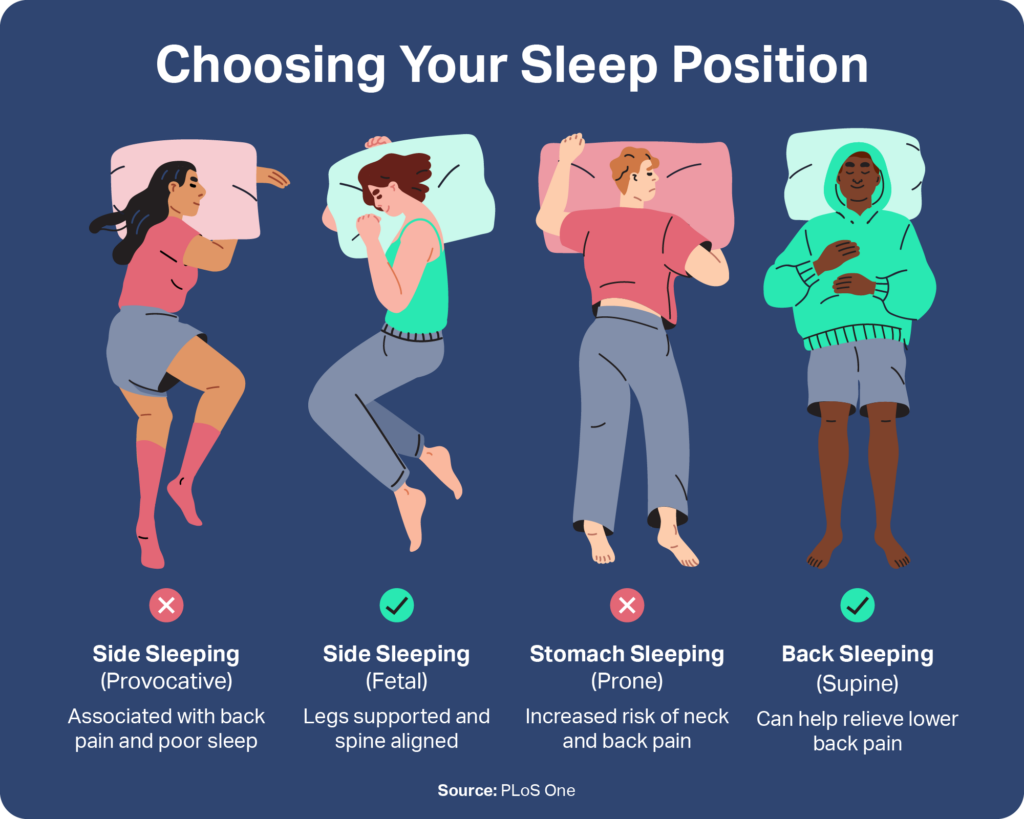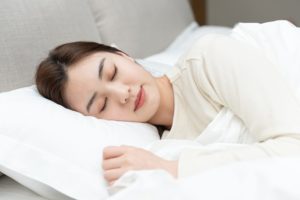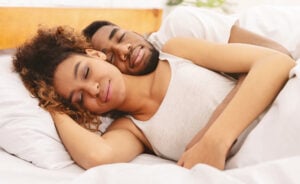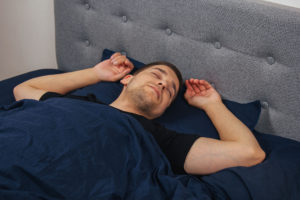Sleep Posture
- Sleep posture impacts sleep quality and overall well-being the next day.
- Good sleep posture can reduce pain and improve breathing and circulatory functions during sleep.
- The best sleep posture depends on personal comfort and health considerations.
- In any position, ensure spinal alignment with a supportive mattress and pillow.
Many products and exercises are available to enhance a person’s posture while they work and move throughout the day. Sleep posture tends to get overlooked, but it is just as important as waking posture—especially since people spend about one-third of their lives asleep.
Good sleep posture can prevent or relieve back pain, reduce snoring, and improve overall sleep quality. Selecting the right bedding and mattress can be key for finding the best sleep position.
Is Your Troubled Sleep a Health Risk?
A variety of issues can cause problems sleeping. Answer three questions to understand if it’s a concern you should worry about.
What Is Sleep Posture?
Sleep posture is the position of the body during sleep. Like sitting and standing, sleep posture is a type of static posture, or the way a person holds their body during periods of inactivity. The way a person moves when walking, exercising, or working is called dynamic posture. People spend significant portions of their day in static postures. Over time, both static and dynamic postures affect overall health and wellbeing.
Posture is a way of describing the position of the spine in relation to other bones and muscles in the body. The spine begins at the base of the skull and curves along the neck and back to the pelvis. Maintaining the natural S-shaped curves of the spine while at rest promotes good posture, better overall sleep quality , and many other health benefits.
However, several factors can make it hard to maintain proper posture.
- Age: As people grow older, they tend to lose some flexibility in their posture. This can cause the spine to become more curved, making it harder to stand up straight. Older adults are also more likely to develop conditions that affect the structure and health of the spine, like arthritis or osteoporosis.
- Mental health: Some evidence shows that a person’s mental state can affect their posture . People who are depressed tend to curve their spines inwards or slump their shoulders. Both depression and anxiety are often associated with chronic neck pain or stiffness.
- Pregnancy: Pregnant people usually have to adjust both their dynamic and static postures to adapt to a growing midsection. In the later stages of pregnancy, people may need to adjust their usual sleep positions or use additional support in bed to find comfort.
- Changes in weight: Extra body weight can affect the strength of abdominal muscles and put additional stress on the spine. A person’s weight can also lead them to choose sleeping on the side over other positions.
- Pain: Both acute and chronic pain can change the way a person moves and holds their body. People who are in physical pain may need to pay careful attention to their static and dynamic postures to help prevent further injury or delayed recovery.
Sleep posture is also influenced by the sleep system , which is the combination of mattress and mattress support, such as a box spring and bed frame. Sleep systems can vary widely in their material components and levels of support or firmness. Selecting the right sleep system is especially important if other factors may be affecting posture or causing discomfort.

Benefits of Good Sleep Posture
Good sleep posture maintains the natural curvature of the spine while a person is lying down. The spine is crucial to body function. It protects the spinal cord and helps balance and distribute weight across the body’s muscles and bones. If a person’s head and neck are not properly supported or their hips are twisted while they sleep, the spine may become misaligned.
Poor sleep posture can lead to neck and back pain, limiting mobility and significantly affecting a person’s quality of life over time. Good sleep posture, on the other hand, reduces the likelihood of waking up with pain and offers a variety of other health benefits.
Reduced Back Pain
Back pain is a common ailment amongst adults of all ages, with about 84% of people reporting back pain at some point. Poor sleep posture can cause back pain and aggravate existing back pain by putting extra strain on the upper or lower spine. For example, sleeping in a prone position, or on your stomach, is associated with neck pain upon waking.
Some sleep postures may reduce the likelihood of back or neck pain. Side sleeping in a curled position called the fetal position, or with one leg supported by bedding, may help prevent or relieve neck and back pain. For some, sleeping in the supine position, or flat on your back, can also help with back pain, as long as the head and neck are sufficiently supported by a pillow.
Better Breathing
During sleep, the muscles around the airway naturally relax. Sometimes, as air flows through the upper airway, these relaxed tissues can flutter and vibrate, causing snoring. Lying flat on the back increases the likelihood of snoring, possibly due to gravity . This position is also associated with obstructive sleep apnea (OSA), a sleep disorder characterized by frequent breathing disruptions due to tissues collapsing into the airway.
For people who snore or have OSA, adjusting the sleep position might alleviate some of their symptoms when combined with other therapies or lifestyle changes. Adults who snore but wish to continue sleeping on their backs might consider using a wedge pillow or adjustable mattress to elevate the head and back.
For people with OSA that gets worse in the supine position, turning to sleep on the side can sometimes reduce the frequency of breathing disruptions.
“Sleeping on the left side helps to keep the airways open, reducing snoring and alleviating mild sleep apnea.”
Dr. Anis Rehman, Internal Medicine Physician
Improved Sleep Quality
Sleep posture directly affects the quality of a person’s sleep. That is, poor posture is associated with poor-quality sleep, while good posture is associated with higher-quality sleep. Sleep quality can be measured subjectively by how well-rested a person reports feeling the next day and objectively by how much time is spent in each stage of sleep and how often they wake up during the night.
A person’s mattress and bedding can make the difference in whether they are able to find a good sleep posture. Research shows that people who sleep on moderately firm mattresses, with bedding that keeps the head and neck aligned with the spine, report better sleep quality, less pain, and decreased levels of stress.
Good posture can also induce longer periods of time in deep sleep, the stage that helps people feel the most refreshed upon waking up.
Choosing Your Sleep Position
The right sleep position for you is whatever position helps you maintain alignment along your spine and feels the most comfortable. Many factors can influence your sleep position, including your age, weight, health, and the mattress and bedding that you use.
Sleep positions are often divided into three main categories: side sleeping, stomach sleeping, and back sleeping. However, there are variations within each of these categories, and some people shift into different positions throughout the night.

Each sleep position can offer benefits and drawbacks, depending on an individual’s needs and personal preferences.
Side Sleeping
Most people prefer side sleeping, also called the lateral position. Side sleeping has several variations, including sleeping on the left or right side, the fetal position, and provocative positions.
In the fetal position, the legs are bent and in alignment, with one leg supporting the other. In a provocative position, a person’s upper body remains on the side, but the hips are twisted and the legs are misaligned, leaving the top leg unsupported. The provocative position is often associated with back pain and poor sleep.
Different side sleeping positions can offer different benefits. People with back pain may find the fetal position most comfortable, as it can take some pressure off the spine. People with congestive heart failure may choose the right side, as this position can alleviate symptoms like shortness of breath.
Meanwhile, pregnant people may opt to sleep on the left side with a pillow between their legs. This position can improve blood flow to the uterus and fetus and alleviate pressure on the liver.
Stomach Sleeping
Sleeping on the stomach, also called the front or prone position, is the least-popular sleep position among adults. Like unsupported side sleeping, lying prone has also been associated with neck pain and poor-quality sleep in some studies.
Sleeping on the stomach may also affect a sleeper’s breathing and energy expenditure. Since gravity affects the chest more in this position, the sleeper’s rib cage has to work harder to expand when breathing in.
Back Sleeping
Back sleeping, or lying supine, is the second-most-common sleep position after side sleeping. It may seem that lying on the back should maintain a spinal alignment similar to standing. However, some studies have shown that the firmness of a person’s mattress can have a significant effect on whether good spinal posture can be obtained in this position.
Sleeping on a soft mattress can cause the head and neck to sit higher than the back, leading to extra stress on the spine. But an overly firm mattress can keep the lower back from making contact with the mattress, resulting in an unnatural curve. For these reasons, some experts recommend medium-firm mattresses for back sleepers.
Back sleeping may benefit some people who have lower back pain that has not been relieved by sleeping in the side position. For people who prefer to sleep on their backs but want to reduce snoring, elevating the head and upper back with an inclined pillow or a custom mattress setting may be useful.
The Importance of Using the Right Mattress
Finding the right mattress can be key when working to improve sleep quality. The choice of mattress can depend on personal preference, cost, or even the desire to find a better sleep posture.
Mattresses can range from firm to soft, but research has shown that a medium-firm mattress works best for most people. Medium-firm mattresses generally provide the most comfort and proper alignment of the spine. Researchers have also found that people get better sleep when their mattresses support good posture and help minimize the need to shift positions throughout the night.
A soft mattress can make the body, especially the hips, sink down in a manner that misaligns the spine. This may cause pain in the neck and lower back due to unnatural spinal curvature. Soft mattress sleepers may find it helpful to use a soft or thin pillow to support the head and improve alignment.
A hard or very firm mattress can provide more support to the head and neck, but this may come with uncomfortable pressure on a person’s skin and soft tissues. Hard mattresses may lead to muscle soreness in the lower back and even skin sores in some circumstances.
Finding the right pillow and bedding also helps optimize the sleep environment. Like mattresses, pillows come in a wide variety of materials and fill options that can influence spinal alignment.
How to Improve Your Sleep Posture
The first step for improving sleep posture is to determine whether your current sleep position is causing any problems or interfering with your sleep. If you have gained or lost weight, become pregnant, or been diagnosed with a sleep disorder like sleep apnea, you may want to reconsider your usual sleep position. Several strategies can help change your sleep position to something that works better for you.
- Positional therapy: Using bedding or other devices to encourage certain sleep positions can help you find a better sleep posture. Positional therapy may involve special pillows, wearable devices, or even the use of a tennis ball sewn into the back of a shirt to prevent back sleeping.
- Pillow firmness: As the primary support for the head and neck, a pillow plays an important role in spinal alignment. Pillow choice may depend on the type of mattress a person is using, as experts often recommend that a softer mattress be paired with a softer pillow.
- Pillow placement: Beyond supporting the head, pillows can also be used to bolster the back or support the hips and knees. If you are a side sleeper, you may consider placing a pillow between your legs or behind your back to help you maintain this position.
- Mind-body exercises: Certain types of exercises, like yoga or tai chi, can help you build awareness of your body and recognize when something is wrong. Knowing when a sleep position is negatively affecting your posture can help you begin to make adjustments.
- Talking to your doctor: If you feel like your sleep posture is affecting the quality of your sleep, or if you find yourself regularly waking up in pain, consult with a health care provider. They may be able to recommend exercises or therapies to help you improve both your sleep posture, waking posture, and overall health.
References
8 Sources
-
MedlinePlus: National Library of Medicine (US). (2017, October 25). Guide to good posture., Retrieved February 22, 2023, from
https://medlineplus.gov/guidetogoodposture.html -
Hong, T. T., Wang, Y., Wong, D. W., Zhang, G., Tan, Q., Chen, T. L., & Zhang, M. (2022). The influence of mattress stiffness on spinal curvature and intervertebral disc stress–An experimental and computational study. Biology, 11(7), 1030.
https://pubmed.ncbi.nlm.nih.gov/36101411/ -
NIH Office of Communications and Public Liaison. (2017, August). Getting it straight., Retrieved February 23, 2023, from
https://newsinhealth.nih.gov/2017/08/getting-it-straight -
Verhaert, V., Druyts, H., Van Deun, D., De Wilde, T., Van Brussel, K., Haex, B., & Sloten, J. V. (2012). Modeling human-bed interaction: The predictive value of anthropometric models in choosing the correct bed support. Work, 41 Suppl 1, 2268–2273.
https://pubmed.ncbi.nlm.nih.gov/22317052/ -
Cary, D., Briffa, K., & McKenna, L. (2019). Identifying relationships between sleep posture and non-specific spinal symptoms in adults: A scoping review. BMJ Open, 9(6), e027633.
https://pubmed.ncbi.nlm.nih.gov/31256029/ -
Yamada, Y., Yamada, M., Chubachi, S., Yokoyama, Y., Matsuoka, S., Tanabe, A., Niijima, Y., Murata, M., Abe, T., Fukunaga, K., & Jinzaki, M. (2022). Comparison of inspiratory and expiratory airway volumes and luminal areas among standing, sitting, and supine positions using upright and conventional CT. Scientific Reports, 12(1), 21315.
https://pubmed.ncbi.nlm.nih.gov/36494466/ -
Cary, D., Jacques, A., & Briffa, K. (2021). Examining relationships between sleep posture, waking spinal symptoms and quality of sleep: A cross sectional study. PLoS One, 16(11), e0260582.
https://pubmed.ncbi.nlm.nih.gov/34847195/ -
Radwan, A., Fess, P., James, D., Murphy, J., Myers, J., Rooney, M., Taylor, J., & Torii, A. (2015). Effect of different mattress designs on promoting sleep quality, pain reduction, and spinal alignment in adults with or without back pain; Systematic review of controlled trials. Sleep Health, 1(4), 257–267.
https://pubmed.ncbi.nlm.nih.gov/29073401/










